|
Among all the reptiles in the world, turtles are the
most popular because they can be kept as pets, though others prefer them
for their meat and beautiful shells. One of the species that have the
ability to live both on land and water, they come in different sizes and
colors, while a few are weird-looking as well. Despite having a bad rep
as disease-carriers and for being aggressive, a lot of people still
prefer to care for them since some of their species are already
endangered.
|
|
10. Spiny Softshell Turtle (Apalone spinifera)
A species of softshell turtle, the bizarre-looking spiny softshell
turtle is one of the largest freshwater species found in the United
States, Canada and Mexico. They were named from their spiny, cone-like
projections on the edge of their shells, which are not scales, and six
subspecies are recognized that have different markings on the sides of
the head, feet and on their carapace. However, these markings are only
distinct in hatchlings since they usually fade once the turtles grow.
First described by Charles Alexander Lesueur in 1827, adults of the
various subspecies are not distinguishable from one another, so their
subspecies are only assigned based on their geography, though the adult
females are usually larger than the males. |
|
 |
|
9. Leatherback Turtle (Dermochelys coriacea)
Sometimes called as the ‘lute turtle,’ the leatherback sea turtle is
considered as the largest of all living turtles and the fourth largest
reptiles after three species of crocodiles at 3m and 916kg. It is
distinguished from other sea turtles by its carapace that is covered by
skin and oily flesh instead of a bony shell. Due to its large,
teardrop-shaped body, it can dive to depths of 4200 feet, making it the
world’s deepest-diver among all reptiles. It also holds the record for
being the fastest reptile with the speed of 9.8m/s in the water. Though
initially named by Domenico Agostino Vandelli in 1761 as Testudo
coriacea when it was first captured, it was later reclassified in 1816
as Dermochelys coriacea due to its leathery texture and appearance;
hence its first names as ‘leathery turtle’ and ‘trunk turtle.’ |
|
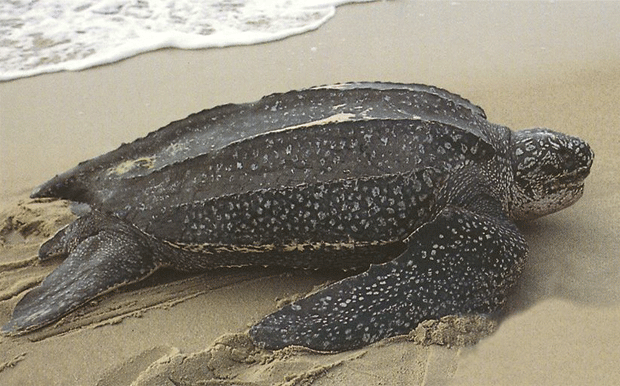
|
|
8. Eastern Long-neck Turtle (Chelodina longicollis)
Included on the weirdest list not only for its appearance, the eastern
long-neck turtle has some interesting traits as well. When it feels
threatened, it will emit a very offensive smelling fluid coming from its
musk glands, making it earn the name ‘stinker.’ Its most distinctive
feature is its long neck, so it bends its head into it shell instead of
directly pulling it back like other turtles. It also has a powerful
webbed feet and a flattened, broad brown shell with black-edged scutes.
Distinctive black lines or seams are also found on its underside plates
and they prefer slow-moving freshwater habitats like dams, swamps and
the lakes of Australia. |
|
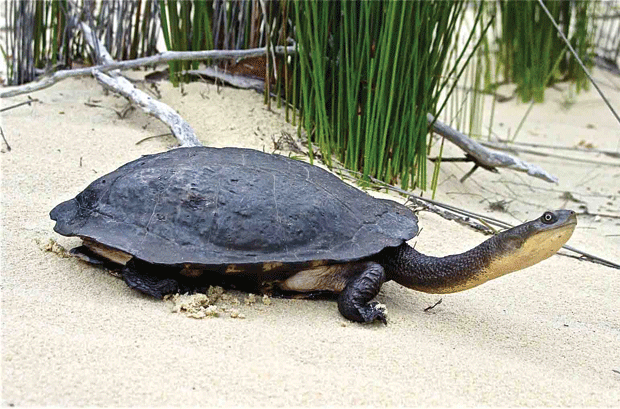
|
|
7. Argentine Snake-necked Turtle (Hydromedusa
tectifera)
A species of turtle known for its long neck, hence its name, the
Argentine snake-necked turtle is one of the most traded pets among the
exotic animals. Though it originated from South America and locally
found in Brazil, Argentina, Paraguay, and Uruguay, it actually came from
Australia. Despite being known as the South American snake-necked
turtle, it is more closely related to the Mata-mata. It can reach up to
11 inches in length and has a carapace or shell that is strongly keeled.
It can also be distinguished by its black and yellow markings on its
head and neck with the females usually larger and have larger tails than
the males. |
|
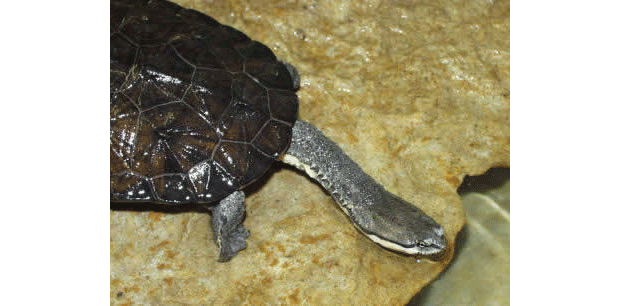 |
|
6. Alligator Snapping Turtle (Macrochelys
temminckii)
One of the largest freshwater turtles in the world, the alligator
snapping turtle is known for its big, heavy head and long thick shell
with three dorsal ridges of large scales, which make it look like the
plated dinosaurs. It also known for eating anything it catches from
snakes, alligators, and other turtles. Though they are often
captive-bred as pets and available in the exotic animal trade, they only
make good pets for experienced aquatic turtle keepers, who can determine
the sex of the alligators based on the temperature at which they are
incubated.
|
|
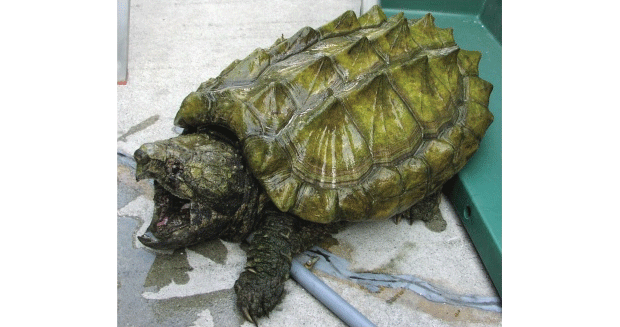 |
|
5. Cantor’s Giant Soft-shelled Turtle (Pelochelys
cantorii)
A strange-looking species of freshwater turtles, the Cantor’s giant
soft-shelled turtle is known for its broad head, small eyes near the
tips of its snout, and smooth and olive-colored carapace. The juveniles
have dark-spotted heads and carapaces, with yellow around it, while the
adult can grow as much as 6 feet in length and weigh more than 100
pounds. It is also known for its unique ability to spend most of its
time buried and motionless underneath the sand with only its eyes and
mouth showing, while surfacing only twice daily to take a breath.
|
|
 |
|
4. Barbour’s Map Turtle (Graptemys Barbouri)
Found in the rivers of southern Alabama, southwestern Georgia, and the
western panhandle of Florida, the Barbour’s map turtle is named after
the American herpetologist Thomas Barbour. It can grow at an average of
3.5 to 5.5 inches in carapace length, though the females can attain
imposing dimensions from 6 to 12.5 inches with their heads enormously
enlarged. The males, however, have black-tipped spines on their 2nd,
3rd, and 4th vertebrae, which resembles a dorsal fin. Their diet mostly
consists of small fish, insects and mollusks; and their ownership is
outlawed both in Alabama and Georgia, while species below 4 inches in
length are not allowed to be sold in Florida.
|
|
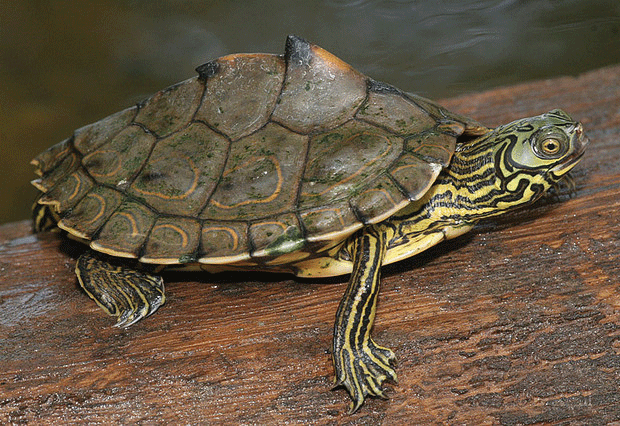 |
|
3. Spiny Turtle Heosemys spinosa)
One of the most unusual-looking turtles in the world, the very
attractive spiny turtle prefers the lowland and hilly rainforest of up
to 900m with small streams nearby in areas in the Philippines, Thailand,
Brunei, Indonesia, Myanmar, Malaysia and Singapore. Also known as the
‘cog-wheel turtle,’ its name was derived from its sharp, pointed and
spiky-edged carapace, and spiny keel. Though nothing is known about
their nesting behavior, their behavior appears to be triggered by the
rain. Females, which develop a plastron hinge to ease laying of eggs,
lay one or two eggs per clutch and produce three clutches per year with
incubations of 106, 110 and 145 days in captivity.
|
|
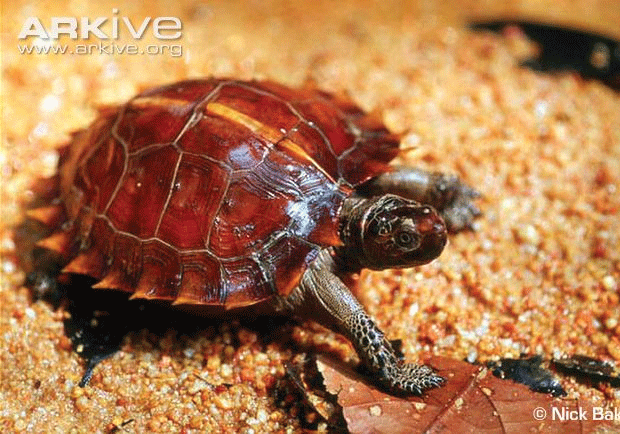 |
|
2. Indian Flap-shelled (Lissemys punctata)
The Indian flap-shelled turtle is a cute-looking turtle that is endemic
to Bangladesh, India, Myanmar, Nepal, Pakistan, and Sri Lanka in South
Asia and was later introduced to the Andaman and Nicobar Islands. A
freshwater species of turtle, it derives its name from the femoral flaps
on its plastron, which cover the limbs when they retract into the shell.
Its carapace, which range from 240 to 370mm in length, is broadly oval
in adults; though it is more circular and wider with the young. It is
known to be omnivorous and feeds on the diet of fish, frogs, snails,
shrimps, aquatic vegetation, flowers, plant leaves, fruits, seeds, and
grasses.
|
|
 |
|
1. Mata mata (Chelus fimbriatus)
A freshwater turtle found primarily in the Amazon and Orinoco basins in
South America, the Mata mata has a shell that resembles a piece of bark,
while its head resembles the leaves falling, which camouflaged its
presence. The weird-looking reptile is a large sedentary turtle that has
a large triangular flattened head with many tubercles and flaps, a horn
on its long tubular snout, three barbels on its chin, and four
additional filamentous barbels on its upper jaw. It also has a brown or
black carapace and measures 18 inches in adult age and weighs 15kg. An
adult has a grayish brown head, neck, limbs, and tail with its neck
longer than the vertebra under its shell and has five webbed claws in
each of its forefoot. Hatchlings, meanwhile, have a pink or reddish
tinge underside of their shell and plastron, which gradually disappears
as they grow.
|
|
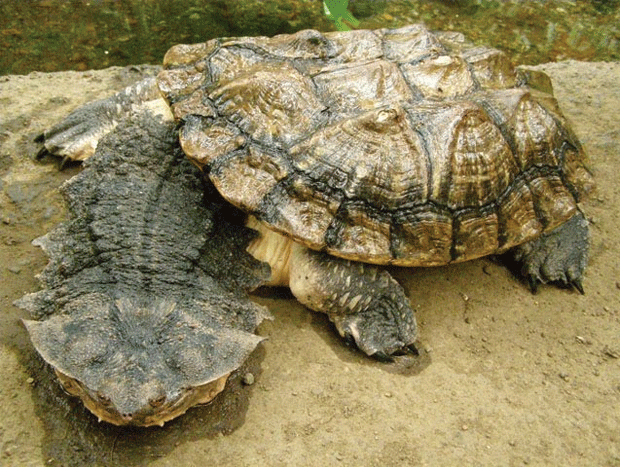 |
|
VIEW PICTURE GALLERY
|
|
|